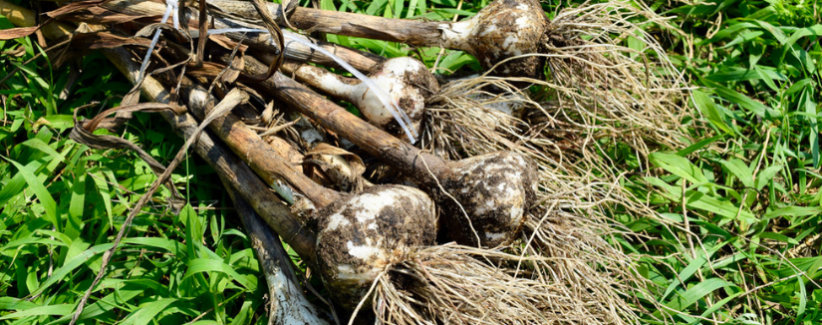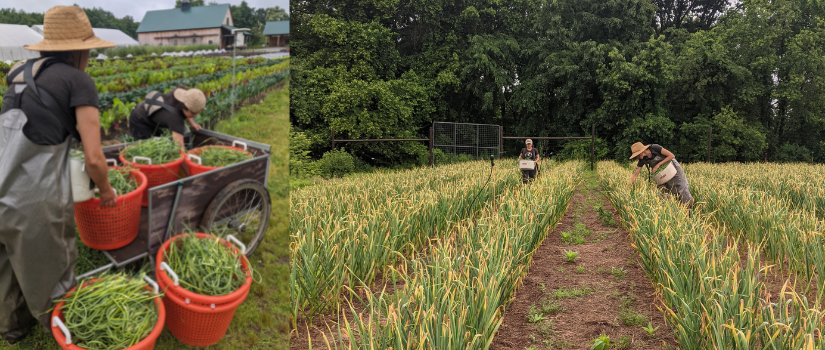A Closer Look at a Farm Favorite: Garlic

Some crops that we grow have a singular presence on the farm. Some have a similar bearing on our cuisine. Garlic is one special crop that manages to have both.
On a normal year, we harvest our garlic from the fields the week of the Fourth of July. It’s not quite like clockwork, but it’s very close. Because of the heavy rains that fell over the first two weeks of the month—nearly nine inches by July 12, making it the third wettest July ever recorded, when the month wasn’t yet half over—we waited to harvest until July 16.

A brief pause in the wet weather finally gave us a chance to let the garlic dry in the ground before being pulled. Farmers Anna, Rae, and Ava were out in the 90-degree heat with the high school farm team, pitchforking between the rows of garlic to loosen their hold in the ground, then pulling them up by the base of their stalks. They crumbled clusters of soil from the roots and untangled nests of salt marsh hay from the stalks as they gathered bundles of the plants on the ground.

To begin the process of drying and curing, we stopped watering the garlic in June and let the tops begin to yellow. After pulling up the garlic plants—with their white bulbs, lush green stalks, and faded, straw-colored tops—the farm team set them out in the grass to allow them to dry in the sun. They then tied them in bundles of 10 and hauled them by the cartload across the farm to the pavilion.
Gathering an armfull at a time, the high school volunteers set about climbing atop our picnic tables for an added boost of height, and hanging them from nails set along the rafters of the pavilion. A dry breeze blows through all summer long, making it the perfect, well-ventilated spot for the garlic to cure over a few weeks.

In the early fall, we’ll cut the tops off above the garlic bulbs, trim the roots, and sort the garlic. We’ll then set aside a portion of the year’s harvest to seed next year’s crop—each garlic clove will grow into a new plant, forming a bulb that consists of five to 10 cloves. This makes garlic one of the few crops at Gaining Ground that we grow from our own seeds.
Once the weather is cool, but before the soil freezes, we’ll plant the garlic—broken apart from the head but leaving the papery husk on each clove—flat end down and pointed end up. Garlic is a heavy feeder on nitrogen, but doesn’t require a lot of space, so we plant them a few inches apart. Once they’re in the ground, we’ll cover them generously with salt marsh hay to help insulate them from the sometimes-harsh New England winter.
This is also why we grow hardneck garlic, as it tends to be extremely cold hardy and has more complex flavors than the softneck varieties found more frequently in grocery stores. Hardnecks also produce scapes—or flower stems—in the spring, which we remove to encourage the plants to direct their energy toward bulb growth. (We harvest the scapes, an early summer treat, and distribute them to our partners.) Unlike our fruiting crops, we don’t need garlic to flower because—although it’s capable of sexual reproduction—we propagate it asexually when we replant its cloves.

In this way, garlic is unique on the farm for its four-season presence and long-term, cyclical nature. We will cultivate a community of garlic at Gaining Ground for years to come, deepening its connection to our farmers, land, and the folks who eat it.
We think of garlic as a great reminder of the history and culture around so many of our crops and our foods. Garlic is a member of the allium family, of which there are around 500 species, including onions, leeks, chives, and ramps. These bulbous vegetables have been cultivated for thousands of years.
The magic of alliums—and garlic especially—comes from their distinctive, sharp, sulfury flavor, which originally evolved to deter animals from eating them (and, depending on who you ask, apparently vampires as well). When cooked, some of these same compounds give these plants their characteristic sweet, nutty, or meaty flavors that make them so popular in cuisines throughout the world.

When we think of hunger relief and food access, the widespread culinary significance of this ancient crop and its nutritional properties make it a true powerhouse. Garlic stores well for long periods of time, compliments the flavors of a huge variety of other foods, and is packed with vitamins and minerals. For its modest size, it provides rich amounts of vitamins B6, C, and Thiamine, and the minerals manganese, phosphorus, and calcium. Studies have also shown that garlic can have positive effects on cardiovascular health.
One of the joys of being around food every day is learning how much it connects us to our past and to each other. Garlic, especially, is a food that inspires wonder in almost every way we encounter it: It is incredibly healthful, an absolute joy to cook with, and—with the right care and conditions—it gives itself back to the farm year after year.